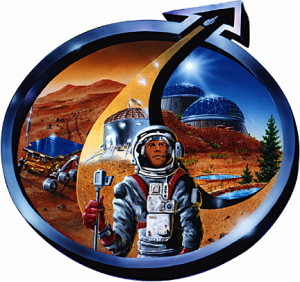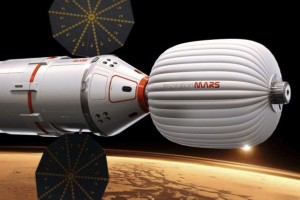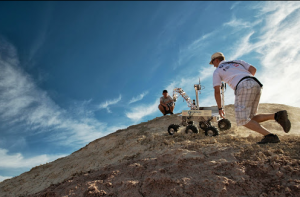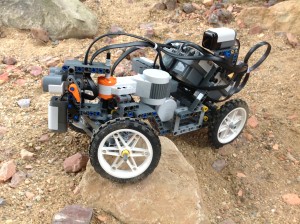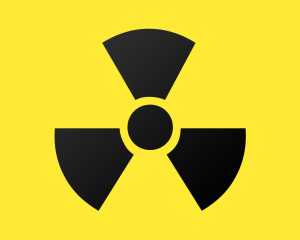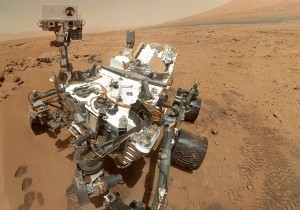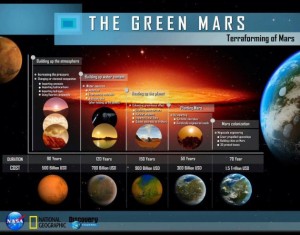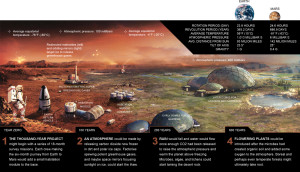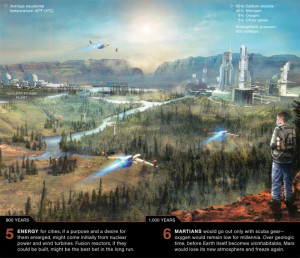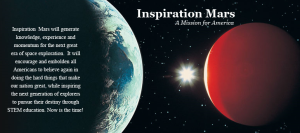by: Nicole Willett
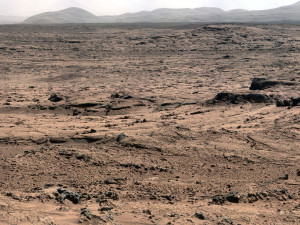 Throughout history, humans have looked at Mars in wonder and have made up myths, legends and science fiction stories about civilizations. When Mariner flew by Mars in 1965 hopes for finding a thriving civilization on the Red Planet were quickly dashed by the 22 postage stamp sized images that slowly trickled back to Earth. The images showed a barren, rocky terrain. For many though, their passion of finding out more details kept the interest in finding life on Mars alive. In 1976 a life detecting experiment invented by Dr. Gil Levin was sent on the Viking I and II Landers to investigate whether microbial life existed in the soil on Mars.
Throughout history, humans have looked at Mars in wonder and have made up myths, legends and science fiction stories about civilizations. When Mariner flew by Mars in 1965 hopes for finding a thriving civilization on the Red Planet were quickly dashed by the 22 postage stamp sized images that slowly trickled back to Earth. The images showed a barren, rocky terrain. For many though, their passion of finding out more details kept the interest in finding life on Mars alive. In 1976 a life detecting experiment invented by Dr. Gil Levin was sent on the Viking I and II Landers to investigate whether microbial life existed in the soil on Mars.
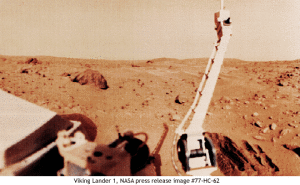 Levin named his experiment Gulliver, but it was renamed by NASA to the Labeled Release (LR) experiment. Viking I and Viking II, which were 4,000 miles away from each other, both carried the LR. A brief summary of the LR is as follows; first a sample of Martian soil is scooped up and sent into a thimble-sized chamber, then a tiny drop of nutrient containing radioactive 14C is squirted onto the soil sample, and, if microorganisms are present, they will consume the nutrient and then give off radioactive gas. When the LR was performed on the surface of Mars, after the first squirt of nutrient was added onto the soil gas immediately began to come off. A spike was seen on the graph tracing the gas, with a growing curve indicating a positive result for life. The gas that was released by this experiment kept slowly evolving for the entire seven days the LR was run. In order to verify the results a control experiment had been designed by NASA. The control was
Levin named his experiment Gulliver, but it was renamed by NASA to the Labeled Release (LR) experiment. Viking I and Viking II, which were 4,000 miles away from each other, both carried the LR. A brief summary of the LR is as follows; first a sample of Martian soil is scooped up and sent into a thimble-sized chamber, then a tiny drop of nutrient containing radioactive 14C is squirted onto the soil sample, and, if microorganisms are present, they will consume the nutrient and then give off radioactive gas. When the LR was performed on the surface of Mars, after the first squirt of nutrient was added onto the soil gas immediately began to come off. A spike was seen on the graph tracing the gas, with a growing curve indicating a positive result for life. The gas that was released by this experiment kept slowly evolving for the entire seven days the LR was run. In order to verify the results a control experiment had been designed by NASA. The control was 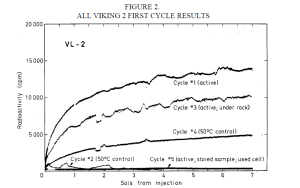 designed to determine whether the result was chemical or biological. The control had a negative result indicating thepositive response was from life. This is because chemistry could not “die” from the modest heat imposed by the control experiment, but a living organism could. Since the control came back negative and the LR was positive, it can be ascertained that there is life on Mars. Thus the LR detected life on Mars according to the criteria set by the Viking team and NASA. Viking I and II both had a positive result for life with the LR experiment. Several different life detecting or life-related experiments were in the payload of Viking. Each one had different degree of sensitivity. The LR was the only test that was positive for life, but it was much more sensitive than the others. The LR was able to detect as few as 20 bacterial cells in its development tests. The other experiments were orders of magnitude less sensitive which easily explains why they were negative versus the positive results of the LR.
designed to determine whether the result was chemical or biological. The control had a negative result indicating thepositive response was from life. This is because chemistry could not “die” from the modest heat imposed by the control experiment, but a living organism could. Since the control came back negative and the LR was positive, it can be ascertained that there is life on Mars. Thus the LR detected life on Mars according to the criteria set by the Viking team and NASA. Viking I and II both had a positive result for life with the LR experiment. Several different life detecting or life-related experiments were in the payload of Viking. Each one had different degree of sensitivity. The LR was the only test that was positive for life, but it was much more sensitive than the others. The LR was able to detect as few as 20 bacterial cells in its development tests. The other experiments were orders of magnitude less sensitive which easily explains why they were negative versus the positive results of the LR.
 The Gas Exchange (GEX) and the Pyrolytic Release Experiment (PR), the other life detections tests, failed to detect life in the soils of Mars. When another experiment failed to find any organic matter in the Martian soil, NASA made a consensus that there was no life on the Red Planet. However, science does not work by consensus. Science is supposed to review any postitive or indicative results and retest them. That is the scientific method every third grader in America learns. Scientists must retest their experiment to get accurate results. If one out of three tests is positive, then you must rerun the positive experiment to get an accurate result. What scientists should not do is stop sending life detection experiments to Mars because their results are deemed ambiguous. NASA has refused to send any other life detection experiments to Mars since then. That is not science. Each time Levin has proposed a new life detection experiment to go to Mars, he has been denied. NASA keeps stating that they are looking for habitats that might have supported life long ago. Nest they say they will look for “biosignatures” of long extinct life. If we had the technology to search for existing life on Mars in 1976, what is stopping us from looking for exixting life on Mars now? We have learned so much more about the Red Planet since then, it should be a slam dunk to send a convincing life detection device to Mars.
The Gas Exchange (GEX) and the Pyrolytic Release Experiment (PR), the other life detections tests, failed to detect life in the soils of Mars. When another experiment failed to find any organic matter in the Martian soil, NASA made a consensus that there was no life on the Red Planet. However, science does not work by consensus. Science is supposed to review any postitive or indicative results and retest them. That is the scientific method every third grader in America learns. Scientists must retest their experiment to get accurate results. If one out of three tests is positive, then you must rerun the positive experiment to get an accurate result. What scientists should not do is stop sending life detection experiments to Mars because their results are deemed ambiguous. NASA has refused to send any other life detection experiments to Mars since then. That is not science. Each time Levin has proposed a new life detection experiment to go to Mars, he has been denied. NASA keeps stating that they are looking for habitats that might have supported life long ago. Nest they say they will look for “biosignatures” of long extinct life. If we had the technology to search for existing life on Mars in 1976, what is stopping us from looking for exixting life on Mars now? We have learned so much more about the Red Planet since then, it should be a slam dunk to send a convincing life detection device to Mars.
Each successive mission to Mars has discovered that Mars definitely has two things, rocks and water. The Viking missions (1976), the Pathfinder and Sojourner Rover (1997), Spirit (2004-2010) and Opportunity Rovers (2004-currently operational), Phoenix Lander (2008), and Curiosity (2012-currently operational) have all confirmed many times over that there are water and rocks on Mars. This has taken nearly 40 years to accomplish, even though we acquired that information with the Viking missions. The next rover, with a working name of Mars 2020, is to be very similar to Curiosity with the addition of a cache to store rock samples in. This cache will be stored on Mars until a later date when another rover or humans (as a NASA scientists stated tongue and cheek) will launch it back to Earth, as a sample return, for further study. But how do they know any Martian life will survive the six to nine-month trip to Earth when we don’t know what they eat, breathe or what environment they need? And, if they do survive, might they be harmful? Bad idea! According to MIT planetary scientist, Dr. Ben Weiss, about one ton per year of Martian meteorites fall to Earth, which over time equals billions of tons of rocks from Mars have arrived on Earth. He states, as do others, “It is possible we are Martians.” Since that is the case, what is the purpose of sending another rover very similar to Curiosity to  Mars to store a cache of rocks on the surface for an unknown amount of time?
Mars to store a cache of rocks on the surface for an unknown amount of time?
This is a perplexing set of facts. So many issues arise with this plan. Such as, contamination upon reentry, time of the cache sitting on the surface of Mars, and lack of foresight and appropriate planning. According to Dr. Robert Zubrin, President of the Mars Society, we get samples of rocks from Mars all the time. We have many meteorites from Mars in labs being studied currently. The mission that should be funded is the Icebreaker Life mission. This mission will have a one meter long drill that will peer below the surface of Mars specifically searching for conclusive evidence of life. (see Issue # 21 for more details) In an email from Dr. Chris McKay he stated, “We are currently working on the Icebreaker mission and we will be proposing it to the current round of Discovery missions. We expect proposals due Dec 2014. We will aim for a 2018 launch.” This is a much more reasonable plan and should have been funded years ago.
Since the controversial Viking results, many scientific journal articles have been published supporting the results while others have attempted to discredit them. Many new experiments have been developed that have supported the LR positive results. At this point it may be a matter of what you choose to believe regarding the LR results. However, science is true whether or not you believe it. I believe there is life on Mars. All of the necessary ingredients are on Mars for life to exist. Mars has ample amounts of water, minerals, and other chemical nutrients in the soil. Habitability has been established and reestablished. The question is, “Do we want to find life on Mars?” It depends who you ask.
A special thank you to Dr. Gil Levin for his years of dedication and hard work on this subject and for his generous time and assistance with this blog.
[Images: NASA, Levin, Astrobio.net]
